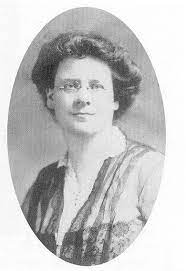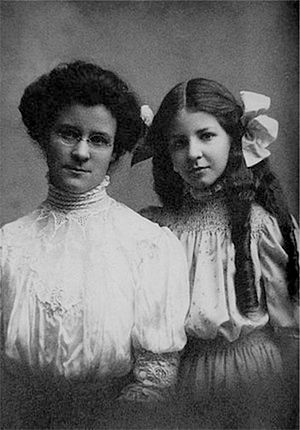Katharine Cook Briggs facts for kids
Quick facts for kids
Katharine Cook Briggs
|
|
|---|---|

Briggs in the early 20th century
|
|
| Born |
Katharine Cook
January 3, 1875 |
| Died | July 10, 1968 (aged 93) Swarthmore, Pennsylvania, U.S.
|
| Nationality | American |
| Known for | Myers–Briggs Type Indicator |
| Spouse(s) | Lyman James Briggs |
| Children | 2, including Isabel |
| Parent(s) | Albert John Cook Mary Harris Baldwin |
Katharine Cook Briggs (born January 3, 1875 – died July 10, 1968) was an American writer. She is best known for creating the Myers–Briggs Type Indicator (MBTI) with her daughter, Isabel Briggs Myers. The MBTI is a special test that helps people understand their personality type.
Contents
Early Life and Education
Katharine Cook Briggs was born on January 3, 1875. Her birthplace was Ingham County, Michigan. Her father, Albert John Cook, was a professor at Michigan State University. Her mother, Mary Harris Baldwin, went to Oberlin College.
Katharine was taught at home by her father. She did not go to a regular school until she was fourteen. At that age, she started college. She earned a degree in agriculture. After college, she worked as a teacher.
Family Life
Katharine married Lyman James Briggs. He was a physicist and worked for the government. He directed the Bureau of Standards in Washington, D.C..
On October 18, 1897, Katharine gave birth to her daughter. Her name was Isabel Briggs Myers. Isabel was their only child who lived past infancy.
Early Research into Personality
Katharine Briggs was very interested in how children learn and grow. She studied different ideas about child development. She even created a test to help children find suitable careers. She believed this was important for their future happiness.
In 1917, her early research led her to find four main personality types. These were meditative, spontaneous, executive, and sociable types. These ideas later helped form the MBTI. She looked at the work of many thinkers. But she could not find one perfect theory of personality. So, she decided to start developing her own ideas.
Writing About People
Katharine wrote articles about raising children and education. She believed children are naturally curious. She thought education helps this natural curiosity grow.
Her interest in personality types started when she tried writing fiction. To make her story characters more real, she wanted to understand people better. She studied human personality and behavior. Her first two articles were published in a journal called New Republic. One was in 1926, and the other in 1928.
How Isabel Joined the Work
In 1923, Briggs read the work of Carl Jung. Jung was a famous psychologist. His ideas focused on how people are naturally different. These differences show up in how they make decisions and take in information. Katharine shared Jung's ideas with her daughter, Isabel.
Isabel was not interested in personality research at first. But she changed her mind. She saw how understanding personality could help people find the right jobs. So, she decided to work with her mother. Katharine and Isabel were greatly inspired by Jung's ideas. They spent twenty years observing different personality types.
In 1945, Katharine and Isabel worked with Lyman Briggs. They gave the first personality assessment to students. These students were at George Washington Medical School. During World War II, Isabel created a test. This test helped identify the best war-related jobs for people. She kept her mother's early work in mind.
The Myers–Briggs Type Indicator
Katharine Briggs spent the rest of her life promoting Jung's ideas. Isabel took over the main studies. She used her own, her mother's, and Jung's observations. This led to the creation of a paper-and-pencil test. This test was designed to figure out a person's personality type.
Katharine was the main inspiration behind the MBTI. Isabel was the one who did the hard work to create the actual test. The MBTI is now used in many areas. These include helping leaders develop and counseling couples.
The MBTI was officially added to the Educational Testing Service in 1962. Since then, about 50 million people have taken the test. The MBTI sorts personality types into four pairs of categories. Katharine and Isabel believed everyone fits into one of 16 possible combinations. Each person has a main preference in each of the four pairs.
The basic structure of the test has not changed much. Some people criticize the MBTI. They say it is not fully scientific. They claim Briggs developed the test at home. They say she did this before doing much scientific research.


